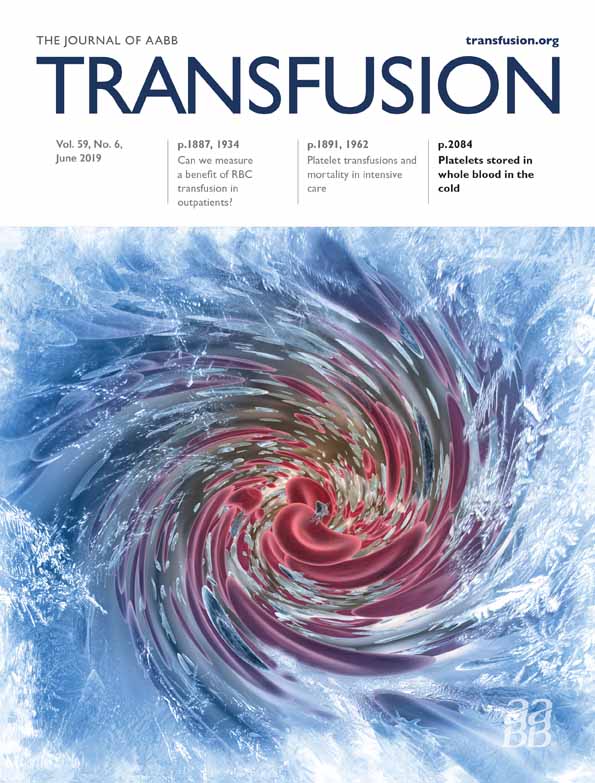REPORT OF NEW ALLELES OR ANTIGENS
A novel allele of the atypical chemokine receptor 1 (ACKR1) gene containing the nucleotide change c.126 T>G (p.42Glu) encodes a third Duffy blood group protein sequence antithetical to that encoding Fya and Fyb antigens
Christof Weinstock,
Corresponding Author
Christof Weinstock
German Red Cross Blood Service Baden-Württemberg – Hessen, Institute Ulm, Institute for Clinical Transfusion Medicine and Immunogenetics Ulm, and Institute of Transfusion Medicine, Ulm University, Ulm, Germany
Address reprint requests to: Christof Weinstock, German Red Cross Blood Service Baden-Württemberg – Hessen, Institute Ulm, Institute for Clinical Transfusion Medicine and Immunogenetics Ulm, and Institute of Transfusion Medicine, Ulm University, Ulm, Germany; e-mail:
[email protected].
Search for more papers by this author Joannis Mytilineos,
Joannis Mytilineos
German Red Cross Blood Service Baden-Württemberg – Hessen, Institute Ulm, Institute for Clinical Transfusion Medicine and Immunogenetics Ulm, and Institute of Transfusion Medicine, Ulm University, Ulm, Germany
Search for more papers by this author Peter Bugert,
Peter Bugert
German Red Cross Blood Service Baden-Württemberg – Hessen, Institute Mannheim and Institute of Transfusion Medicine and Immunology, Heidelberg University, Medical Faculty Mannheim, Mannheim, Germany
Search for more papers by this author Nicole Sitzmann,
Nicole Sitzmann
German Red Cross Blood Service Baden-Württemberg – Hessen, Institute Mannheim and Institute of Transfusion Medicine and Immunology, Heidelberg University, Medical Faculty Mannheim, Mannheim, Germany
Search for more papers by this author Elke Pensel,
Elke Pensel
German Red Cross Blood Service Baden-Württemberg – Hessen, Institute Ulm, Institute for Clinical Transfusion Medicine and Immunogenetics Ulm, and Institute of Transfusion Medicine, Ulm University, Ulm, Germany
Search for more papers by this author Hubert Schrezenmeier,
Hubert Schrezenmeier
German Red Cross Blood Service Baden-Württemberg – Hessen, Institute Ulm, Institute for Clinical Transfusion Medicine and Immunogenetics Ulm, and Institute of Transfusion Medicine, Ulm University, Ulm, Germany
Search for more papers by this author Daniel Fürst,
Daniel Fürst
German Red Cross Blood Service Baden-Württemberg – Hessen, Institute Ulm, Institute for Clinical Transfusion Medicine and Immunogenetics Ulm, and Institute of Transfusion Medicine, Ulm University, Ulm, Germany
Search for more papers by this author
Christof Weinstock,
Corresponding Author
Christof Weinstock
German Red Cross Blood Service Baden-Württemberg – Hessen, Institute Ulm, Institute for Clinical Transfusion Medicine and Immunogenetics Ulm, and Institute of Transfusion Medicine, Ulm University, Ulm, Germany
Address reprint requests to: Christof Weinstock, German Red Cross Blood Service Baden-Württemberg – Hessen, Institute Ulm, Institute for Clinical Transfusion Medicine and Immunogenetics Ulm, and Institute of Transfusion Medicine, Ulm University, Ulm, Germany; e-mail:
[email protected].
Search for more papers by this author Joannis Mytilineos,
Joannis Mytilineos
German Red Cross Blood Service Baden-Württemberg – Hessen, Institute Ulm, Institute for Clinical Transfusion Medicine and Immunogenetics Ulm, and Institute of Transfusion Medicine, Ulm University, Ulm, Germany
Search for more papers by this author Peter Bugert,
Peter Bugert
German Red Cross Blood Service Baden-Württemberg – Hessen, Institute Mannheim and Institute of Transfusion Medicine and Immunology, Heidelberg University, Medical Faculty Mannheim, Mannheim, Germany
Search for more papers by this author Nicole Sitzmann,
Nicole Sitzmann
German Red Cross Blood Service Baden-Württemberg – Hessen, Institute Mannheim and Institute of Transfusion Medicine and Immunology, Heidelberg University, Medical Faculty Mannheim, Mannheim, Germany
Search for more papers by this author Elke Pensel,
Elke Pensel
German Red Cross Blood Service Baden-Württemberg – Hessen, Institute Ulm, Institute for Clinical Transfusion Medicine and Immunogenetics Ulm, and Institute of Transfusion Medicine, Ulm University, Ulm, Germany
Search for more papers by this author Hubert Schrezenmeier,
Hubert Schrezenmeier
German Red Cross Blood Service Baden-Württemberg – Hessen, Institute Ulm, Institute for Clinical Transfusion Medicine and Immunogenetics Ulm, and Institute of Transfusion Medicine, Ulm University, Ulm, Germany
Search for more papers by this author Daniel Fürst,
Daniel Fürst
German Red Cross Blood Service Baden-Württemberg – Hessen, Institute Ulm, Institute for Clinical Transfusion Medicine and Immunogenetics Ulm, and Institute of Transfusion Medicine, Ulm University, Ulm, Germany
Search for more papers by this author
First published: 08 March 2019
No abstract is available for this article.
CONFLICT OF INTEREST
CW received honoraria for speaking at symposia organized by Grifols. The remaining authors declare no conflicts of interest.
REFERENCES
- 1Chaudhuri A, Polyakova J, Zbrzezna V, et al. The coding sequence of Duffy blood group gene in humans and simians: restriction fragment length polymorphism, antibody and malarial parasite specificities, and expression in nonerythroid tissues in Duffy-negative individuals. Blood 1995; 85: 615-21.
- 2Höher G, Fiegenbaum M, Almeida S. Molecular basis of the Duffy blood group system. Blood Transfus 2018; 16: 93-100.
- 3 Database of single nucleotide polymorphisms (dbSNP). Bethesda (MD): National Center for Biotechnology Information, National Library of Medicine. (dbSNP Build ID: 146). [cited 2018 Aug]. Available from: http://www.ncbi.nlm.nih.gov/SNP
- 4 Exome aggregation consortium (ExAC), Cambridge (MA). [cited 2018 Aug]. Available from: http://exac.broadinstitute.org
- 5 Genome aggregation database (gnomAD), Cambridge (MA). [cited 2019 Jan]. Available from: http://gnomad.broadinstitute.org




